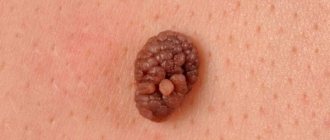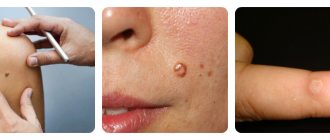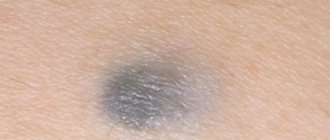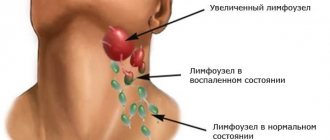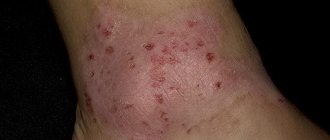Warts , or papillomas, are manifestations of the activity of the human papillomavirus (HPV) in the body. The disease has a viral basis and actively develops in cases where a person’s immunity is significantly reduced. It is considered benign and does not cause problems, provided, of course, that the locations of the warts are not subject to constant trauma. Although warts are a relatively safe and even common phenomenon, a change in their size or shape, the manifestation of signs of inflammation and, especially, darkening, should be a reason to pay close attention.
What they look like
In appearance, a common wart on the body looks like a papilla with a rough or uneven surface. There is often a change in the size of the papilloma, for example, it has darkened or become covered with small patches in the form of dark dots.
There are no clear age limits when a black wart appears, nor a specific place on a person’s skin where it can be localized. Growths with black roots appear on the hands, in particular on the fingers, on the face, on the body in the genital area, feet, and neck. If the wart begins to turn black, it is important to determine the cause of its change and eliminate the factor that is unsafe for the body.
Black dots on the surface
Sometimes a person notices warts with black dots. Dark spots formed on the surface are the result of blockage of the capillaries that feed the growth.
A wart with black dots on the sole is the result of infection or dirt getting under the skin. In both cases, you cannot do without consulting a doctor.
Wart with black roots
Even one darkened black rod indicates that the formation is taking on a more complex and unsafe form. In the early stages, the roots have a flesh-colored tint. But over time, filled with blood vessels, they become darker in color. Often the body copes with papillomas on its own, which simply disappear. However, this factor is not a sign of complete recovery - under favorable circumstances, the virus can recur.
It happens that the roots of the wart turn black due to its death and drying of blood clots under the skin. Blood clots prevent normal nutrition of the skin. A visit to a dermatologist in such a situation is necessary, because the resulting blood clots can negatively affect a person’s well-being.
Rules for caring for a wound after cauterization
In order for the restoration of the skin to be successful, without negative consequences and complications, it is necessary to follow the rules of wound care:
- It is forbidden to wet the wound. It is not recommended to take a bath for the first 3 days after surgery.
- After starting water procedures, cover the wound with a plaster to prevent water from entering. After bathing, gently wipe the affected area with a paper towel. It is unacceptable to rub with a towel.
- Change dressing materials regularly. During treatment, use antiseptic agents to prevent dirt from entering the open wound after removal with nitrogen and blood.
- Do not touch the affected area unless necessary. This can injure the area, causing inflammation and prolonged healing.
- It is forbidden to try to cut or pick off a wart. This can lead to the development of complications, which is dangerous in the matter of wound healing and for human health.
- It is necessary to protect the growth from direct sunlight. This includes limiting your time on the beach or visiting the solarium.
- It is forbidden to pierce a bubble with liquid. Under the thin film of the blister there are ideal conditions for the growth of bacteria.
- The crust that appears after the bubble bursts is not peeled off. Otherwise, the risk of scarring or scarring increases.
- It is not recommended to use decorative cosmetics if the growth is on the face. You should avoid using aggressive hygiene products (belongings, masks).
- If the wart is located on the foot, you should limit wearing shoes. For heel wounds, you will have to give up heels and uncomfortable platforms for several months.
- Treatment after removal with nitrogen should be carried out only with products prescribed by the attending physician.
Compliance with all the rules for caring for a wart will help shorten the rehabilitation period. The growth dies off within 2 weeks. During normal healing, after nitrogen removal, the skin will be completely cleared within 1 month.
Why does a wart turn black?
The wart turns black as a result of the following reasons:
- Deterioration of health as a result of long-term use of antibiotics and other medications.
- Frequent visits to swimming pools, public showers, saunas. Exacerbation of any chronic disease.
- Natural death of black wart.
- Stressful situations and depression.
If dark areas form in the middle of condylomas, this means that changes are occurring that can lead to a deterioration in health. Practice shows that you should beware of darkened flat papillomas of small sizes. They appear and quickly grow in small scatterings in one area of the body. In men they appear in the chin area, in women they affect the lower extremities, in children and adolescents they usually form on the face. If the wart has turned black, you can find out why this happened after completing the examination from a specialist.
Sometimes black growths appear on the body. Such warts are called senile warts; they do not pose a threat to health.
Necessary actions
In addition to darkening of the skin formation, doctors advise consulting a dermatologist if other signs occur:
sharp outline of contours;
Important! Such signs may indicate the degeneration of a neoplasm into a malignant tumor.
If a wart turns black after exposure to celandine juice or liquid nitrogen, this is a natural phenomenon. Soon the growth should fall off the surface of the skin on its own, leaving a small pink scar in this place. The person’s task is to make sure that the root of the formation is also removed.
Some formations (for example, plantar ones) have very deep roots. If the growth turns black and falls off, but the root remains in the skin, the formation will reappear on the surface of the sole.
If the color of the growth changes as a result of injury, it is necessary to prevent infection of the damaged area. In addition, a damaged wart will lead to activation of the virus, then growths will appear not only near this area of the skin, but also in other parts of the body.
Algorithm of action in case of injury:
- Usually the wound begins to bleed, then a cotton pad soaked in hydrogen peroxide should be applied to the damaged area.
To avoid bacterial infection, the wound should be treated with an antiseptic solution. The use of colored disinfectants (Iodine, Diamond green, Fukortsin pink) is not recommended.
During a subsequent examination, the doctor will need to determine the presence of a root at the site of damage. After treating the wound with a colored antiseptic, this will be difficult to do. For sanitation, you can use Chlorhexidine or Miramistin.
Usually, blackened or bleeding growths need to be removed.
It is advisable to carry out removal with the help of a qualified specialist. Today, many methods have been invented to remove unwanted growths on the skin. Among them are pharmaceutical products with a keratolytic effect, usually gels, ointments and patches with salicylic acid (Salicylic acid, Salipod, Collomac). Necrotizing agents (Vartek, Verrukacid) are also used. Preparations with a freezing effect are popular: Wartner Cryo. Their effect is similar to the procedure of freezing with liquid nitrogen (after which the growths often turn black).
The most effective way to remove tumors is through cosmetic procedures:
- cryodestruction;
- laser therapy;
- radio wave method;
- removal with liquid nitrogen.
Any neoplasm on the skin must be monitored, as there is a risk of the appearance of atypical cells.
If you find a blackened wart, you should not do anything on your own: tear it off, cut it off, or burn it with iodine or celandine. Modified growths should be treated only after examination by a dermatologist.
source
Is there any danger
If the wart turns black, you need to take immediate measures to treat it. Such changes are a serious signal of danger. When a benign papilloma with a light base transforms into a malignant wart with black roots, the following symptoms are observed:
- Discomfort at the site of the lesion.
- Roughness and flaking of the skin.
- Severe and persistent itching, in which a person scratches and damages the integrity of the skin.
- Suppuration and bleeding.
Usually darkened spots on the growth are easily visible. Plantar warts, or thorns, are especially troubling. Their peculiarity is the rapid appearance of so-called daughter seals, on which black dots are clearly visible - these are capillaries for replenishment.
If a wart with black roots is damaged, you should immediately seek qualified help.
When a wart turns black but does not fall off, you should never cut it off yourself. Qualified treatment in the clinic is indicated.
Don't miss a dangerous disease!
The main danger in the presence of warts is not to miss the dangerous disease, its first symptoms in the form of changes in growths and not to confuse them with other skin formations. What can papilloma be confused with:
- Mole. It may be flesh-colored or light brown, but does not have a rough structure and does not become keratinized.
- Age-related hyperkeratosis. Flat, does not rise above the skin level, rough to the touch. It is brown in color and occurs in old age. Appears in several places throughout the body.
The main task is not to miss skin cancer. It can manifest itself as a small wound, constantly bleeding, non-healing, have an irregular shape, and grow quickly.
source
Diagnostics
Black warts on the body are diagnosed based on clinical manifestations. Their appearance, when the shape and color changes, should be a good reason to visit a dermatologist. The main reason for neoplasms with black spots is their possible degeneration into malignant growths - this is the most dangerous sign. During diagnosis, the doctor must exclude:
- moles,
- calluses,
- seborrheic keratosis,
- lichen planus,
- tumors.
If the patient complains of discomfort caused by black papilloma, a biopsy is performed, and sometimes human papillomavirus DNA typing is prescribed.
What treatment is needed
Most experts are of the opinion that it is better to remove blackened warts. In each specific case, the method of such treatment may differ. The most commonly prescribed methods for removing growths are:
- Use of chemicals . In this case, the doctor burns out the blackened growth. The only disadvantage of this treatment is the formation of a scar at the site of the wart.
- Carrying out surgery . The most common negative consequence is the occurrence of heavy bleeding. No less rare is secondary infection of the wound, as well as the formation of a more extensive lesion in the same area.
- Laser therapy. Using a laser on a wart, you can get rid of it in just one procedure. After laser therapy, a certain burn remains on the skin, which requires specific care.
- Cryo-treatment and radio wave therapy. Such methods of getting rid of a blackened wart are used only when the above methods are ineffective.
Treatment of the papilloma virus present in the human body must be carried out comprehensively. Surgery alone is not enough for a complete cure.
After surgery, it is recommended to take all measures to improve the condition of the immune system.
This will help reduce the progression of the virus, as well as reduce the risk of new growths appearing. Medicines with a similar effect include Ribomunil, Anaferon, Isoprinosine, etc.
What to do if the wart turns black
If black dots appear on the wart or it sharply increases in size, a trip to a dermatologist and immunologist is required. At the medical institution, a primary examination and examination is carried out, as a result of which the cause of the darkening of the papilloma is determined. In some cases, the growths die and disappear on their own, but you should not hope for self-healing. The papilloma virus, under favorable circumstances, quickly spreads throughout the human body. Modern methods of removing blackened warts:
- Use of acid-containing drugs.
- Over-the-counter pharmaceuticals.
- Cauterization using electricity.
- Laser therapy.
- Cryotherapy.
Advanced cases require surgical intervention. During the operation, the entire papilloma is removed along with the horses and adjacent areas of healthy tissue.
Combined pharmaceutical products
Combination medications are used to remove warts. When choosing them, the doctor takes into account the general condition of the person, his individual characteristics and drug tolerance:
- Antiviral medications that prevent the activity of the virus.
- Keratolytics that soften the horny part of the growth.
- Necrotizing and mummifying drugs that promote the destruction of altered cells.
- Refrigerants that freeze papillomas, which leads to their death.
Laser removal
The emerging black root of a wart can be removed almost painlessly. For this purpose, a laser technique is used, which is highly effective. Initially, the problem area of skin with a blackened wart is anesthetized, so that the patient does not feel pain during the removal of the papilloma. The laser is usually used to remove several growths at the same time. In this way, growths are often removed from the foot and sole.
Traditional methods
After consultation with a specialist, you can carry out home treatment for black warts on the skin:
- Fresh celandine juice, which is released in sufficient quantities when a branch is broken. You can use this juice several times throughout the day until complete recovery.
- Cut a clove of garlic and rub it on the affected areas 5 times a day until the papilloma disappears.
- Chop a few cloves of garlic and mix with three tablespoons of apple cider vinegar. Let the resulting mass sit for several hours, express the juice, which can then be used to lubricate black warts. The course of therapy is until complete recovery.
Folk remedies are effective and accessible to every person. The main thing is not to cause the growth of a wart with black roots and remove it in a timely manner.
Cryodestruction
This method involves removing black papilloma by freezing it. The dermatologist applies liquid nitrogen to the affected area, which causes the wart to die. Under the influence of low temperatures from -180 to -196 degrees, the compaction cells are completely destroyed and necrosis occurs. Upon completion of the procedure, the growth should fall off, and a healthy layer of skin appears in its place.
Other methods and tools
An effective method for removing warts with black spots is chemical. For this purpose, medications are used to burn out the darkened roots. The procedure is carried out in hospital and at home. Its disadvantage is the formation of scars, so it is not recommended for use when removing black warts on the face and open areas of the body.
The gentle Papilite product consists of a complex of natural ingredients that gently act on the area affected by the wart and do not leave burns on the adjacent healthy skin. The drug stimulates the immune activity of the epithelium at the cellular level. The HPV is destroyed and permanently removed. Full recovery occurs within a few weeks.
Removal by radio waves is often prescribed. Using a radio wave knife, the growth is excised, and the cut site is cauterized with high-frequency waves. The peculiarity of the method is its non-contact effect on human skin and the absence of bleeding.
Recipes for every day
If black dots stick out and the wart has turned black, doctors recommend a special first aid algorithm. The affected area of skin (foot, palm) should be immersed in warm water, then thoroughly wiped dry. Then apply ointment (Salipod) to the growths and secure the patch. Leave for a day. An effective remedy is salicylic acid. It should also be applied to the affected area of the skin. After 2-3 procedures, the wart may disappear without a trace. Before starting a course of treatment, permission from a specialist is required.
A traditional therapy method is the use of thyme. The healing decoction will soften the skin and help remove the growth. Pour a glass of boiling water over the dry herb and leave for 60 minutes. One portion of the resulting infusion can be used 2 times. Before wetting the affected areas, warm the broth. Repeat the procedure once every 2 days. Quick effect with celandine. This plant is popularly called “warthog” because it completely removes rough growths in a few procedures. Celandine extract or juice can be purchased at the pharmacy. Apply only to affected skin. If the juice gets on healthy areas, a burn may develop.
First aid
Any damaged papilloma must be treated with an antiseptic. The ideal option would be hydrogen peroxide, which will not only disinfect the wound, but also stop the bleeding.
It is not recommended to use coloring antiseptic solutions to treat injured black warts, since it will be difficult for a dermatologist to determine the condition of the wart - whether it has come off with roots or not. Growths with black dots indicate the presence of roots. Only after their removal does the papilloma completely disappear.
After treatment with peroxide, the damaged papilloma must be sealed with a band-aid. This will prevent infection.
Prevention
To prevent the appearance of condylomas on the body, it is necessary to follow the rules of personal hygiene, get rid of bad habits, and try not to walk barefoot in public places (swimming pools, baths, saunas). Also avoid direct contact with people who have warts.
In addition, constantly strengthen your immunity. Thanks to these rules, you can avoid the appearance of not only growths on the body, but also many other diseases.
In order to prevent the appearance of these unpleasant formations on the skin, you should constantly follow the rules of personal hygiene. It is strictly not recommended to walk barefoot in crowded places (especially in bathhouses and swimming pools).
Also, you should not abuse wearing shoes in which your feet sweat, and most importantly, do not touch your own, and even more so, other people’s warts, or objects used by a person suffering from this unpleasant infection.
Good nutrition, constant strengthening of the immune system, protection from stress and the ability to relax are the key to guaranteed relief not only from warts, but also from many other possible diseases.
In addition, constantly strengthen your immunity. Thanks to these rules, you can avoid the appearance of not only growths on the body, but also many other diseases.
The blackening of a wart is a pathology; in a normal state this should not happen. This phenomenon indicates a possible circulatory disorder, infection and a number of other problems. This article discusses in detail all the reasons for the change in the color of the growth.
